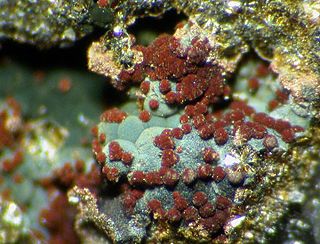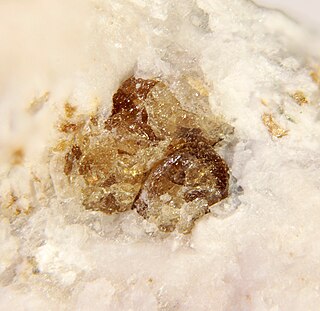Related Research Articles

Robertsite, Ca3(Mn3+)4[(OH)3| (PO4)2]2·3(H2O) (alternatively formulated Ca2(Mn3(PO4)3O2)(H2O)3), is a secondary phosphate mineral named for Willard Lincoln Roberts (1923–1987), mineralogist and professor at South Dakota School of Mines in Rapid City, South Dakota.

Cabalzarite is a rare arsenate mineral with the chemical formula Ca(Mg,Al,Fe3+
)
2[AsO
4]
2•2(H
2O,OH). It is a member of the tsumcorite group. It crystallizes in the monoclinic system and typically occurs as clusters of crystals or granular aggregates.

Fougèrite is a relatively recently described naturally occurring green rust mineral. It is the archetype of the fougèrite group in the larger hydrotalcite supergroup of naturally occurring layered double hydroxides. The structure is based on brucite-like layers containing Fe2+ and Fe3+ cations, O2− and OH− anions, with loosely bound [CO3]2− groups and H2O molecules between the layers. Fougèrite crystallizes in trigonal system. The ideal formula for fougèrite is [Fe2+4Fe3+2(OH)12][CO3]·3H2O. Higher degrees of oxidation produce the other members of the fougèrite group, namely trébeurdenite, [Fe2+2Fe3+4O2(OH)10][CO3]·3H2O and mössbauerite, [Fe3+6O4(OH)8][CO3]·3H2O.

Cyrilovite (NaFe33+(PO4)2(OH)4·2(H2O)) is a hydrous sodium iron phosphate mineral. It is isomorphous and isostructural with wardite, the sodium aluminium counterpart.

Golyshevite is a rare mineral of the eudialyte group, with the formula Na10Ca3Ca6Zr3Fe2SiNb(Si3O9)2(Si9O27)2CO3(OH)3•H2O. The original formula was extended to show both the presence of cyclic silicate groups and silicon at the M4 site, according to the nomenclature of the eudialyte group. The characteristic feature of golyshevite is calcium-rich composition, with calcium at two main sites instead of one site. Together with feklichevite, fengchengite, ikranite and mogovidite it is a ferric-iron-dominant representative of the group. It is chemically similar to mogovidite. Golyshevite was named after Russian crystallographer Vladimir Mikhailovich Golyshev.
Mogovidite is a very rare mineral of the eudialyte group, with formula Na9(Ca,Na)6Ca6(Fe3+,Fe2+)2Zr3[]Si(Si9O27)2(Si3O9)2(CO3)(OH,H2O)4. The formula given is based on the original one but extended to show the presence of cyclic silicate groups. It is similar to feklichevite, differing from it in the presence of essential vacancies and carbonate group. Another specific feature is the dominance of ferric iron - a feature shared with other eudialyte-group members, including feklichevite, fengchengite, golyshevite and ikranite. Similarly to golyshevite, it is calcium-dominant, however on three sites: M(1), N(3) and N(4). It has a molecular mass of 3,066.24 gm.
Arakiite (IMA symbol: Ark) is a rare mineral with the formula (Zn,Mn2+)(Mn2+,Mg)12(Fe3+,Al)2(As3+O3)(As5+O4)2(OH)23. It is both arsenate and arsenite mineral, a combination that is rare in the world of minerals. Arakiite is stoichiometrically similar to hematolite. It is one of many rare minerals coming from the famous Långban manganese skarn deposit in Sweden. Other minerals bearing both arsenite and zinc include kraisslite and mcgovernite.
Bijvoetite-(Y) is a very rare rare-earth and uranium mineral with the formula (Y,REE)8(UO2)16(CO3)16O8(OH)8·39H2O. When compared to the original description, the formula of bijvoetite-(Y) was changed in the course of crystal structure redefinition. Bijvoetite-(Y) is an example of natural salts containing both uranium and yttrium, the other examples being kamotoite-(Y) and sejkoraite-(Y). Bijvoetite-(Y) comes from Shinkolobwe deposit in Republic of Congo, which is famous for rare uranium minerals. The other interesting rare-earth-bearing uranium mineral, associated with bijvoetite-(Y), is lepersonnite-(Gd).
Feodosiyite is a very rare chloride mineral, just recently approved, with the formula Cu11Mg2Cl18(OH)8•16H2O. Its structure is unique. Feodosiyite comes from the Tolbachik volcano, famous for many rare fumarolic minerals. Chemically similar minerals, chlorides containing both copper and magnesium, include haydeeite, paratacamite-(Mg) and tondiite.
Bartelkeite is an exceptionally rare mineral, one of scarce natural germanium compounds. The formula was originally assumed to be PbFeGe3O8, bartelkeite was later shown to be isostructural with a high-pressure form of the mineral lawsonite. Thus, its correct formula is PbFeGe(Ge2O7)(OH)2•H2O. Bartelkeite and mathewrogersite are minerals with essential (dominant) lead, iron and germanium. Both come from Tsumeb, Namibia - a world's "capital" of germanium minerals.

Cerianite-(Ce) is a relatively rare oxide mineral, belonging to uraninite group with the formula (Ce,Th)O
2. It is one of a few currently known minerals containing essential tetravalent cerium, the other examples being stetindite and dyrnaesite-(La).
Belakovskiite is a very rare uranium mineral with the formula Na7(UO2)(SO4)4(SO3OH)(H2O)3. It is interesting in being a natural uranyl salt with hydrosulfate anion, a feature shared with meisserite. Other chemically related minerals include fermiite, oppenheimerite, natrozippeite and plášilite. Most of these uranyl sulfate minerals was originally found in the Blue Lizard mine, San Juan County, Utah, US. The mineral is named after Russian mineralogist Dmitry Ilych Belakovskiy.
Plášilite is a very rare uranium mineral with the formula Na2(UO2)(SO4)2•3H2O. Chemically related minerals include natrozippeite, belakovskiite, meisserite, fermiite and oppenheimerite. Most of these uranyl sulfate minerals were originally found in the Blue Lizard mine, San Juan County, Utah, US. The mineral is named after Czech crystallographer Jakub Plášil.
Chrysothallite is a rare thallium-bearing chloride mineral with the formula K6Cu6Tl3+Cl17(OH)4•H2O. Chrysothallite is unique in being only the second mineral with essential trivalent thallium, a feature shared with natural thallium(III) oxide, avicennite. Another examples of natural thallium chlorides are steropesite, Tl3BiCl6, and lafossaite, TlCl. Chrysothallite is one of numerous fumarolic minerals discovered among fumarolic sites of the Tolbachik volcano, Kamchatka, Russia The mineral is named in allusion to its colour and thallium content.
Nuragheite is a rare natural thorium molybdate, formula Th(MoO4)2·H2O, discovered in Su Seinargiu, Sarroch, Cagliari, Sardegna, Italy. This locality is also a place of discovery of the other thorium molybdate - ichnusaite, which is a trihydrate.
Wiklundite is a rare and complex arsenite-silicate mineral with the chemical formula Pb2(Mn2+,Zn)3(Fe3+,Mn2+)2(Mn2+,Mg)19(As3+O3)2(Si,As5+O4)6(OH)18Cl6. The mineral characterizes in a large c unit cell parameter. It was found in Långban, Sweden - a home for many rare and exotic minerals.

Segnitite is a lead iron(III) arsenate mineral. Segnitite was first found in the Broken Hill ore deposit in Broken Hill, New South Wales, Australia. In 1991, segnitite was approved as a new mineral. Segnitite has since been found worldwide near similar locality types where rocks are rich in zinc and lead especially. it was named for Australian mineralogist, gemologist and petrologist Edgar Ralph Segnit. The mineral was named after E. R. Segnit due to his contributions to Australian mineralogy.
The sulfate fluorides are double salts that contain both sulfate and fluoride anions. They are in the class of mixed anion compounds. Some of these minerals are deposited in fumaroles.
References
- ↑ "Aspedamite: Aspedamite mineral information and data". Mindat.org. Retrieved 2016-03-04.
- ↑ Cooper, M.A., Abdu, Y.A., Ball, N.A., Černý, P., Hawthorne, F.C., and Kristiansen, R., 2012. Aspedamite, Ideally []12(Fe3+,Fe2+)3Nb4[Th(Nb,Fe3+)12O42]12{(H2O),(OH)}12, a New Heteropolyniobate Mineral Species from the Herrebøkasa Quarry, Aspedammen, Østfold, Southern Norway: Description and Crystal Structure. The Canadian Mineralogist 50, 793-804; DOI: 10.3749/canmin.50.4.793
- ↑ "Menezesite: Menezesite mineral information and data". Mindat.org. Retrieved 2016-03-04.
- ↑ "Peterandresenite: Peterandresenite mineral information and data". Mindat.org. Retrieved 2016-03-04.